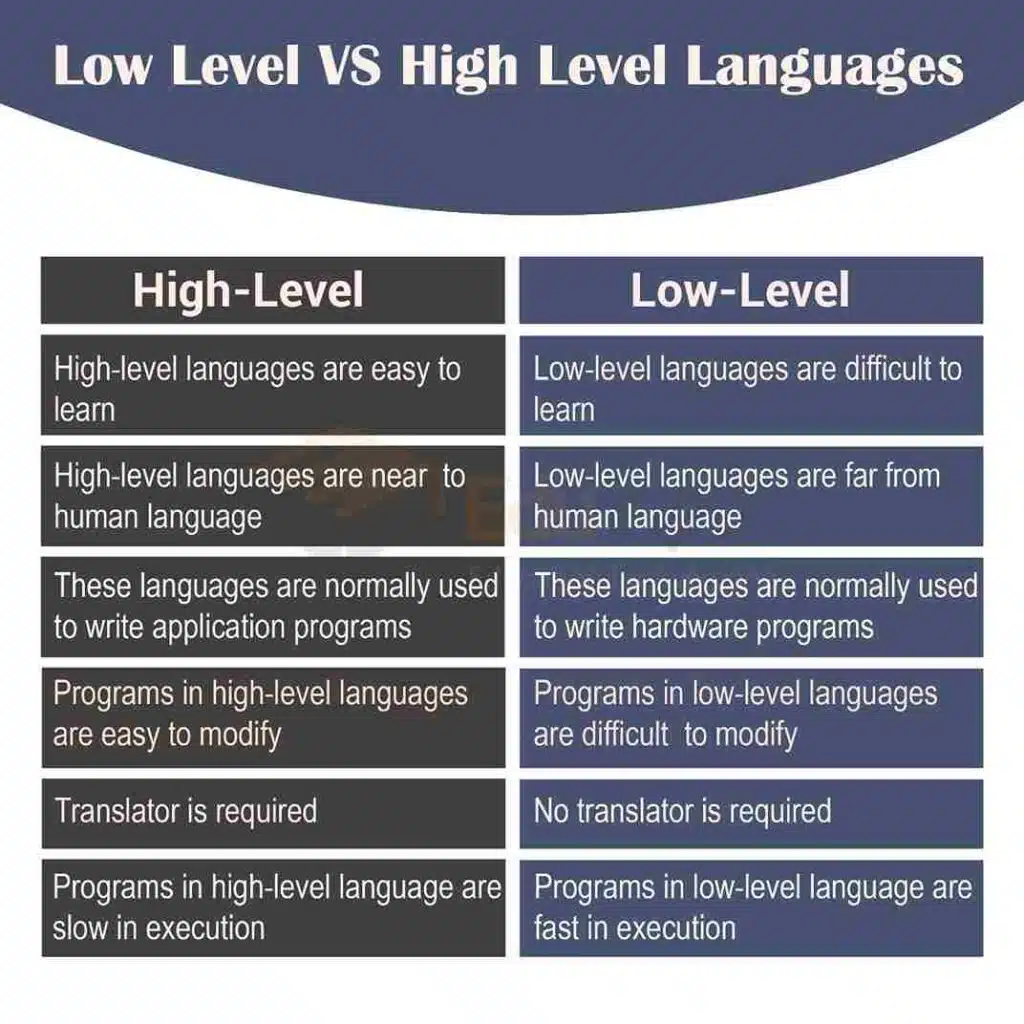Difference between low-level language and high-level language
Low-level languages and high-level languages both are programming languages. The main difference between a high-level programming language and a low-level programming language is that high-level languages are designed to be more easily understood by humans, while low-level languages are designed to be more easily understood by machines.
High-level language
High-Level Language (HLL) is a programming language that uses a higher-level abstraction than C language or C++ language. HLLs are often easier to learn and use than lower-level languages, and they’re generally faster to write and execute.
A good example of a high-level language is Python. Python provides many useful features, including object-oriented programming, dynamic typing, and automatic memory management. These features make it easier to program than C/C++, but they don’t require any special knowledge of how computers work.
Low-level language
Low-Level Language (LLL) is a term used to describe a programming language that is not high-level. In contrast to high-level languages, LLL does not have any abstractions. Low-level languages are often used to write operating systems, compilers, and assemblers.
Low-level languages work directly with a computer’s hardware and instruction set architecture.
Low-level language has some disadvantages. For example, this language is too close to the hardware, which makes it harder to structure some programs. Be careful when using it to avoid making mistakes that could significantly increase the work and revision of the code.
Difference between low-level language and high-level language
| High-Level Language | Low-Level Language |
| High-Level Languages are easy to learn. | Low-Level Languages are difficult to learn |
| High-Level Languages are near to human languages. | Low-Level Languages are far from human languages. |
| A translator is required. | No translator is required. |
| Programs in high-level languages are slow in execution. | Programs in low-level languages are difficult to modify. |
| Programs in high-level languages are easy to modify. | Programs in low-level languages are difficult to modify. |
| High-level languages do not provide many facilities at the hardware level. | Low-level languages provide the facility to write programs at the hardware level. |
| Deep knowledge of hardware is not required to write programs. | Deep knowledge of hardware is required to write programs. |
| These languages are typically used to write application programs. | These languages are typically used to write hardware programs. |
| High–level languages are programmer-friendly languages | Low–level languages are machine-friendly languages |
| Debugging is easy. | Debugging is complex. |
| Needs more time for execution. | Needs less time for execution. |
| Do not depend on machines. | Depends on machines. |
| Examples: Pythons, Perl, BASIC, COBOL, Pascal, Ruby, etc. | Examples: Machine and assembly code. |

Related FAQs
What is the difference between high and low-level language?
High-level languages use a compiler or interpreter for machine code translation, while low-level language uses an assembler to translate machine language instructions directly. Memory efficiency for these languages is very low.
What is a low-level language example?
Examples of low-level languages are machine and assembly code.
What is a high-level language example?
Pythons
Perl
BASIC
COBOL
Pascal
Ruby, etc.
What are the features of high-level language?
High-level language features include but are not limited to automatic memory management, garbage collection, interfacing with the kernel, extensive error checking, and complex arithmetic or boolean expressions.







Leave a Reply